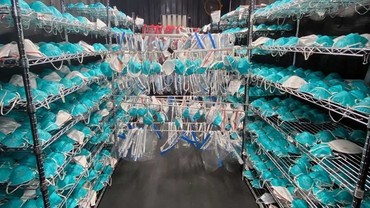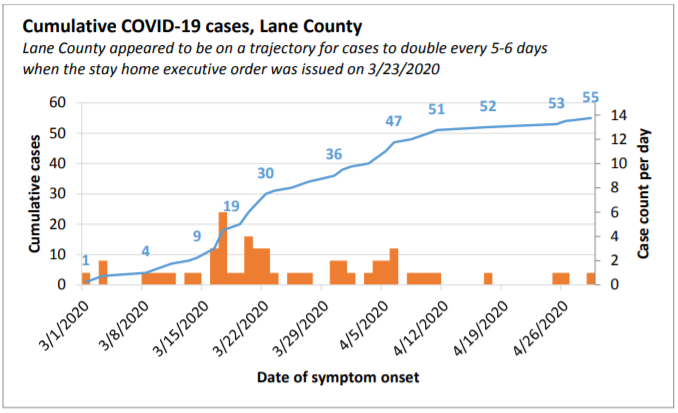Coronavirus update 10: May 8, 2020
Dear friends,
The BIG news of the week is having a plan for reopening, and that Lane County is submitting its plan to the state for approval. In addition to all the specifics about reopening, I’m including a few shorter interesting items.
Wash your hands!
Cordially,
 And Team Nathanson: James and Lindsay
Eugene will host one of the nation’s 60 decontamination units

A decontamination system is being installed at the University of Oregon to sanitize N95 respirator masks. Those are the masks used to protect frontline healthcare workers and that have been in short supply during the pandemic. The new system will receive, sanitize, and return PPE to hospitals and health care facilities all over the state, allowing N95 respirators to be used up to 20 times rather than its typical single use. This development also helps Lane County meet requirements for Phase 1 reopening.
The Federal Emergency Management Agency plans to cover the expenses, provide staff, and manage operations. While state and private procurement of PPE has improved in recent weeks, decontamination will significantly increase the lifespan of Oregon’s supply of N95 masks.
See more in the announcement from UO here and a video on how the machine works here.
|
Weekly shipments of PPE
Health care settings including hospitals, dental clinics, and veterinary clinics are now released to perform non-urgent procedures requiring personal protective equipment (PPE). Anticipating increased demand of PPE, the Office of Emergency Management introduced new guidelines for distributing PPE. The new distribution process calls for weekly deliveries to Oregon’s counties and sovereign tribes, and an allocation system to evaluate local needs and ensure supplies are not stockpiled in some locations and unavailable in others. The needs-based formula considers factors such as population, case counts and PPE per patient, ensuring is PPE is sent when and where it is most needed. Local public health agencies are also being asked to track their “burn rates” of PPE, so OEM can track how the equipment is being used and better understand supply and demand needs. See more information here.
Free virtual summer camp for high schoolers
 |
|
In response to COVID-19, Area Health Education has had to cancel their summer their MedQuest summer camp, but is offering the camp virtually at no cost. High school students who are interested in the healthcare field can participate in virtual tours, podcast interviews with healthcare providers, mental health first aid, and more.
Please help spread the word to any high schoolers you know who may be interested in exploring a career in healthcare!
Register here.
|
Broad plan to stop the spread
Oregon has released a new plan for active surveillance to stop the spread of COVID-19. “Surveillance” is a tactic that public health officials commonly use to identify outbreaks. It helps them control or stop the spread and track health data and outcomes. For viruses like the seasonal flu, surveillance is “passive,” which involves setting rules about disease reporting and tracking, so officials can decide when to take further action.
COVID-19 requires a more active type of surveillance. This has several components. Public health workers stay in regular contact with people who have been diagnosed with the virus. To the extent possible, they also use “contact tracing” to identify and frequently test the people with whom they come in close contact. These contacts will be asked to quarantine and isolate; this will be voluntary and non-punitive. The goal of active surveillance and contact tracing is to control spreading of the virus and ensure that sick people receive the health care they need. The plan can be found here.
Regional reopening
Reopening is a gradual process involving three distinct phases, which require specific approval at the county level depending on local circumstances.
-
Phase I: Limited permission for certain types of facilities to open, while maintaining physical distancing and limits on the size of gatherings. See below for the approval criteria. If the county demonstrates success in controlling the virus spread for 21 days, it can apply for permission to enter Phase II. Success criteria include less than a five-percent increase in cases over any seven-day period, plus stability in the hospitalized caseload. Each kind of business or recreation area must follow new protocols for keeping all patrons safe.

-
Phase II: An increase in the allowable size of the gatherings, allowing some work in offices, and visitations to nursing homes and other group settings. Specifics are still being worked out.
-
Phase III: Larger gatherings such as concerts, festivals, sports with audiences, conventions and fairs will be allowed, but only after a vaccine or curative treatment for COVID-19 is generally available.
How will reopening proceed?
Counties and health regions are now submitting applications to be approved for the first phase of reopening. Many rural counties have had very few hospitalizations; some counties have not even had a positive case. Some counties began submitting their Phase I applications yesterday; Lane County is expected to submit its application by today, May 8.
On the recommendation of OHA, the State is now strongly recommending that everyone wear a homemade mask or facial covering in public where six feet of physical distance is difficult to maintain.
Criteria that must be met before receiving approval to enter Phase I include the following:
-
New case history: If a county has had more than five hospitalizations in the last 28 days, it must show there has been a decline in COVID-19 admissions for the past two weeks.
-
Testing capacity: Capacity to perform 30 tests per 10,000 people per week. Priority is given to individuals with symptoms, or who have had contact with confirmed COVID-19 cases, or who live in congregate living facilities where there is a positive case. Frontline and essential workers not able to practice optimal distancing will also receive priority.
-
Contact tracing: 15 contact tracers per 100,000 people, and ability to trace 95% of contacts for new cases within 24 hours. Contact tracers should include people with language and culturally specific knowledge reflective of the region.
-
Isolation and quarantine facilities: Hotel rooms or shelters for individuals who cannot self-quarantine or self-isolate.
-
Business and recreation guidelines Follow statewide guidelines to protect employees and consumers and reduce risk of transmission.
-
Health care system capacity: Accommodate a 20% increase in COVID-19 like hospitalizations after Phase I is entered.
-
PPE Supply: Hospitals must report PPE supply daily to the Oregon Health Authority (OHA). Large hospitals must have a 30-day supply of PPE and small or rural hospitals must maintain a 14-day supply.
The Details: Here is the presentation which lays out all aspects of reopening that have been worked out so far, the prerequisites for Phase I, the general guidance that everyone must follow in public, and specific sector guidance for outdoor recreation, personal care (salons, barber shops, etc.), restaurants, bars, and retail stores.
It’s important to understand that life will not return to “normal” until we have a vaccine or cure for COVID-19. Until then, the primary tools we have are still practicing physical distancing and good hygiene habits. Every restriction we lift will risk increased disease transmission and increase cases.
Even when we get to Phase II:
- Vulnerable populations and sick people will need to stay at home
- Visitation to nursing homes and hospitals, gatherings and travel will all be limited
- We’ll need to keep paying increased attention to hygiene, cleaning and sanitation, and work from home if that’s feasible.
More links to Reopening plan
Video presentation on Phases of Reopening Oregon
Prerequisites for Entering Phase I
Reopening general guidance for The Public and Employers
Safety guidance: Outdoor Recreation, Personal Services (salons, barber shops, etc), Restaurants & Bars, Retail stores
What does this mean for Lane County?
The Lane County Board of Commissioners endorsed the County Blueprint for Reopening on May 5, and updated the plan today. The plan is to submit their application to enter Phase I today, May 8, to the Governor. The Blueprint outlines how Lane County meets the criteria for opening, including a target goal of testing 500 per day, with at least 100 of those tests available for individuals in high-risk populations. The contact tracing plan includes six-person teams: four contact tracers and two community service workers, who provide support to those in isolation. The team is led by a nurse or Disease Investigation Specialist, and three teams share an epidemiologist and a supervisor. The number of teams needed depends on the number of positive test results, the concentration of contacts, and the supports needed for isolation. Lane County hospitals have sufficient capacity to handle a surge and there is currently a 30-day supply of PPE on hand.
 |
This graph shows how Lane County has "flattened the curve." The blue line shows projections of COVID-19 cases before physical distancing measures were put in place. Orange bars represent the number of new cases every day.
New tax rule helps more small businesses
The Department of Revenue filed a new rule that will help small businesses subject to the corporate activity tax (CAT). Businesses have been asking for relief due to the economic emergency resulting from COVID-19.
The CAT was created in 2019 to support the Student Success Act, designed to create long-needed investments in our K-12 education system. Unfortunately, like most other aspects of our lives, the COVID-19 pandemic has thrown school budgets into uncertainty. We’re likely to be facing significant budget cuts to classrooms, unless the federal government is able to provide billions in support to states like Oregon.
Under the new rule, businesses subject to the CAT but owing less than $10,000 will not have to make quarterly estimated payments and will not have their CAT payment due until April 15, 2021. The previous threshold was $5,000.
This rule change raises the threshold of taxable commercial activity of about $1.8 million to about $2.7 million. Taxable commercial activity is the commercial activity of a business after subtracting the allowable deductions. Less than 10% of Oregon businesses are subject to the CAT, and of those, it is estimated that over half are not required to pay any quarterly estimated tax.
Lane County Public Health COVID-19 How testing works video
Oregon Health Authority (with a link to subscribe to their news service)
Oregon Health Plan (open enrollment)
University of Oregon webpage on UO's COVID-19 response
Oregon Office of Emergency Management OEM COVID-19 response
Employment Department: for business: Work Share
Unemployment Insurance Online Claims and new Pandemic Unemployment Assistance
Bureau of Labor and Industries Coronavirus and Workplace Laws
Department of Human Services.
Department of Education
Oregon Food Bank's Food Finder
Oregon Coronavirus Information, including Stay Home, Save Lives Executive Order FAQ
|